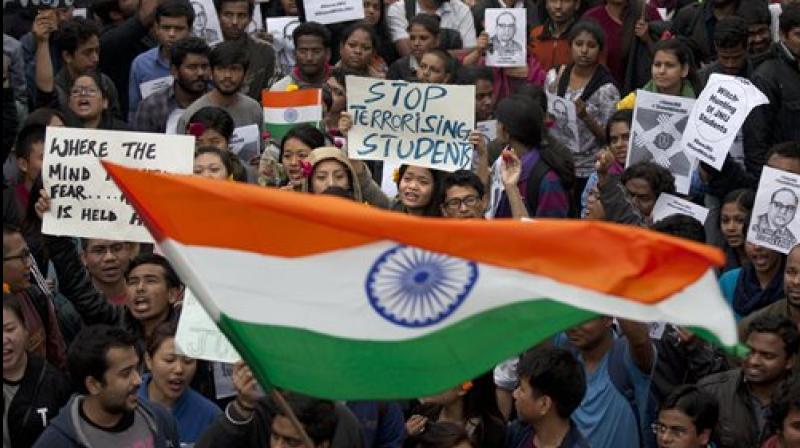Is A 270 Ft National Flag In Central Universities The Answer?

NEW DELHI: All the 46 central universities in the country will fly the national flag on their campuses to signify a “strong India”, said a resolution adopted at a meeting of vice chancellors chaired by HRD Minister Smriti Irani. The very first campus, undoubtedly to initiate this trend would be Jawaharlal Nehru University.
The question is, do we need to hoist the national flag atop a 207-feet pole in central university campuses? Does the government believe that this cursory trend of ‘nationalising’ Indian universities would immediately inculcate its brand of patriotism within students? Quite honestly, educational institutions should have the freedom of raising dissent, arguments, discussions, which forms a part of inner democracy. But this move, which would have consequences in the coming months, is debatable.
To start with, instead of investing in educational institutions, instead of raising the non-UGC Net scholarship from paltry Rs5000 per month to students who are pursuing their research, the Education Ministry rather wants to invest in this ‘forced inculcation of patriotism’. Secondly, having a flag, no matter how high it is, would not saffronize Indian educational institutions. It would not be able to cut down the arguments against India, the intellectual debate which goes within campuses like JNU where the ‘Right to Dissent’ is practiced. Thirdly, this step instead seems as a hurried act to stifle the student voices rising within the campus of JNU after the recent arrest of Kanhaiya Kumar, the JNUSU President. In the tensed atmosphere built in currently, such a step, getting a nod from the VC would just further reiterate the manner in which educational institutions are falling prey to political agendas.
Fourthly, this step would further embolden the ABVP student wing in the campuses, be it Hyderabad University or Allahabad University, where these student wings have carried out their ‘hooligan’ activities, raising a storm all over the country. This step, which perhaps will become a laughing stock in the coming days hints the grave days that are approaching us, silently. No, we do not have a return of Indira Gandhi’s Emergency, but yes, we have something similar happening currently, which is unofficial, yet not a glib.
Nivedita Menon has rightly pointed out ‘The Modi regime, in its bid to be a global superpower through a route that transforms ‘Made in India’ to ‘Make in India’, in a re-inscription of the colonial division of labour in which India offers cheap labour to global capital, is right to target universities and young people. It is these that pose one of the most formidable challenges to the savarna Hindu nationalist and neo-liberal vision of India, and which continue to foreground social justice, equality and freedom, the values enshrined in our Constitution.’
Wasn’t it enough to hoist a large national flag on 207 feet high mast, second largest national flags of India, in Connaught Place on 7th March 2014 in a very subtle yet penetrating way to thrust the hegemony of BJP in public spaces? Now, the same trend would be unleashed in central universities, which are currently battling with their own problems, especially the amount of money spent on student’s education in grants, the protest for which has been quietly thwarted away in a corner.
By no means, the analysis considers the move as retrogressive, but at the same time, it’s not progressive at all. There’s a difference in feeling patriotic for your country by yourself, your own inculcated values, your sense of right and wrong, your idea of nationalism rather than being forced, disciplined or perhaps punished to do so. In the latter discourse, it would cause more internal apathy because educational universities bestow spaces to students to have their own intellectual acumen, to stand with the state or question it. And the questioning does not make anyone less nationalist than the other. Both the processes should be welcomed by the universities under the Right to Freedom of Speech and Expression.
Unfortunately, the current regime, instead of investing in student’s education and empowerment is much more deluded by tacit tactics to create a sense of their own political euphoria which would not mean anything concrete in the end. It would be a matter of great shame that the national flag if unfurled in the campuses, would eventually lead to loss of value towards Mother India or nationalism, as an antithetical reaction from the student bodies. What we need now, is a synthesis and not a dogma perpetuated by the highest echelons.
(The writer is a doctoral student at JNU, New Delhi)



